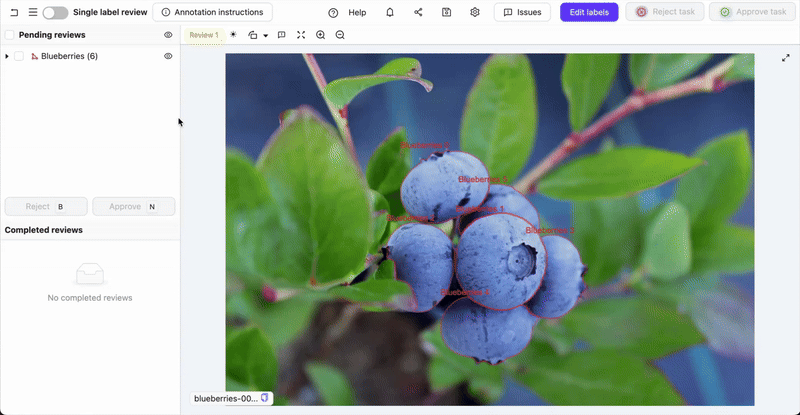To ensure seamless data loading in Encord, allowlist https://app.encord.com/ or https://app.us.encord.com/ in any 3rd party VPNs, firewalls, or URL isolators. This helps to prevent potential issues with opening your data in Encord.
Review Mode
Introductory Videos
The following video goes through the basics of reviewing images in the Label Editor.
Review Mode Components
- A. Editor menu
- B. Single label review toggle
- C. Quick toolbar
- D. Pending reviews pane
- E. Completed reviews pane
- F. Reject and Approve buttons
- G. Editor timeline (for videos and image sequences only)
- H. Editor header
- I. Edit labels during review
- J. Approve and Reject all in frame buttons
Single Label Review
The normal review mode displays all labels simultaneously, allowing you to quickly approve or reject many labels in bulk actions. Alternately, enter the Single label review mode by toggling the switch at the top left. The single label review mode automatically highlights the selected instance, and hides all other objects. This allows you to carefully review one instance at a time including their attributes, and quickly iterate through the different instances using the Up and Down keys on your keyboard or by clicking the appropriate buttons in the UI.
The Single label review feature can also be considered “turbo review mode,” analogous to the “turbo attribute mode” in annotation mode, because it allows the reviewer to quickly step through and review instance attributes. “Turbo attribute mode” in the editor settings can be disabled while in review mode.
- Open the editor settings by clicking in the editor header.
- In the General settings section adjust the Set the default zoom level for single label view value highlighted in the screenshot below. The settings will be applied for the next selected label.

- Initially, the default is set to 60%
- 20% corresponds to no zoom. It’s the magnification at which the image or frame is displayed in the Label Editor.
- To zoom in, increase the percentage value.
- To zoom out, decrease the percentage value. The minimum value is 1%.
Edit Labels During Review
It is sometimes faster, more convenient, and less error-prone to have reviewers make edits to annotations, instead of outright rejecting them. Rejection requires the return of the entire set of labels to the annotator. Edit review allows reviewers to make changes to labels, remove labels, and add new labels. Approved or rejected labels cannot be edited. Only Pending labels can be edited by reviewers. New labels made by editors are automatically approved, and cannot be changed once they have been saved. Once all labels have been approved the task moves to the Complete stage. To edit labels in review mode:- Click the Edit labels button.

- Add or remove labels, or edit existing labels as necessary using the same interface annotators use to create labels.
- Click the Save and return to review button to save your edits and return to review mode.
The Save and return to review button replaces the Save and Cancel buttons used in earlier versions of this feature.

Pending Reviews Pane
All labels for review for a particular data asset assigned to the reviewer are automatically loaded into then Pending reviews pane. The labels are grouped by Ontology class.Completed Reviews Pane
Completed reviews are displayed in the Completed reviews pane. You can click on specific objects to highlight them. Labels can be selected and then approved or rejected for a given instance or in bulk using the Reject and Approve buttons or the matching hotkeys, b for reject and n for approve. Approved labels appear in a green background and rejected labels appear in red.Approve and Reject All In Frame Buttons
The Approve all in frame and Reject all in frame buttons take the named action without having to select a particular instance or set of instances. This speeds up workflows, particularly in images, where you can judge whether all instances are correct or not by looking at an individual frame.Reject and Approve Buttons
To reject/approve multiple object instances across frames, select the instances, and then click the Reject or Approve button, as appropriate. Alternately, you may press b for reject and n for approve.Change Review Judgement
Video Tutorial - Strict review & change review judgment
Video Tutorial - Strict review & change review judgment

- Revert labels to pending :
- Revert an approved task to pending by clicking the green tick icon next to the instance.
- Revert a rejected task to pending by clicking the red cross icon next to the instance.
- Once the reviewer completes their review, they need to click the Approve task or Reject task to finalize the review.
Controls Common To Both Modes
The current workflow status is displayed in the top left corner of the label editor.
Editor Layout
You can customize the default Label Editor layout by uploading a JSON file that defines your preferred arrangement. These JSON files can be added in the Project settings and are applied to all tasks in a Project. Custom editor layouts depend on a file’sclient_metadata or their DICOM tags. This means that custom editor layouts only work for files that contain client_metadata or DICOM tags. Watch the video tutorials below to learn how it fits together.
Introduction to custom editor layouts for DICOM - Video Tutorial
Introduction to custom editor layouts for DICOM - Video Tutorial
Introduction to custom editor layouts (Client metadata) - Video Tutorial
Introduction to custom editor layouts (Client metadata) - Video Tutorial
- Navigate to the Project settings.
- Click on Editor Layouts.
- Click Upload JSON.
- Select the JSON file containing the layout you want the Label Editor to have.

topLevelGridFilter
topLevelGridFilter
The operator value must be Another example is displaying images from the same patient together in the Label Editor using the
=. This means the value must be equal to.topLevelGridFilter to group tasks based on a patient-id.grid
grid
The This configuration translates to the following visual layout:
grid key defines the basic layout of the Label Editor. The grid is a list of lists, where each value represents a window.In the following example, the values 0, 1, 2, and 3 represent individual windows. The layout is defined as two separate lists [0, 1] and [2, 3], resulting in a 2x2 grid configuration:
gridContent
gridContent
The  In the following example, window
In the following example, window
gridContent key specifies what content to display in each window defined in the grid. It includes the following elements:- Grid Values: Assigns content to each window based on its grid value.
-
Content Query: Defines the criteria for displaying content, which can be either
dicom_tags_queryorclient_metadata_query. -
Conditions: Specifies the conditions for displaying the content, which can be either
and_conditionsoror_conditions. -
Operator value can only be
=. This means the value must be equal to.
0 displays content based on a dicom_tags_query with specific conditions.- The
dicom_tags_queryspecifies that the content is determined by DICOM tags. - The
and_conditionskey specifies that all conditions listed must be met for the content to be displayed. - There are two conditions:
- The DICOM tag
00185101must equalCC. - The DICOM tag
00200062must equalR.
- The DICOM tag

1 displays content based on a client_metadata_query with specific conditions.- The
client_metadata_queryspecifies that the content is determined by client metadata. - The
or_conditionskey specifies that any of the conditions listed must be met for the content to be displayed. - There are two conditions:
- The client metadata
group-idmust equalA. - The client metadata
group-idmust equalB.
- The client metadata
group-id is either A or B.1
Add client metadata to files
Editor layouts are based on DICOM tags for DICOM files or on
client_metadata for all other use cases. We provide templates for common mammography layouts based on DICOM tags here.This example uses client_metadata. The following SDK script can be used to add client metadata to specific data units in a Dataset.2
Create a JSON file
Create a JSON for specifying the editor layout that suits your needs.In the JSON file below:
-
The
gridarrangement is configured to display two files side by side in the Label Editor. -
The
gridContentsection specifies that tasks in either position (0 or 1) can have client metadata values forencord-EditorGridPositionset to eitherAorB. -
The
topLevelGridFilteris defined asencord-LayoutGroup, meaning tasks with matchingencord-LayoutGroupmetadata values are displayed together in the Label Editor, ensuring they appear side by side when they share the sameencord-LayoutGroupvalues.
3
Create a JSON file
Upload the JSON file to your Project in Encord.
- Navigate to the Project settings.
- Click on Editor Layouts.
- Click Upload JSON.
- Select the JSON file containing the layout you want the Label Editor to have.

4
Create a JSON file
Open any task in the task queue of your Project.The JSON file in this example results in the following Label Editor layout.

Editor Menu

- Return to Project - Returns the user to the Project navigation.
- Save changes - Saves the current state of all labels.
- View - Allows users to change what information is displayed next to all labels.
- Bulk label operations (annotation mode only) - Allows the user to perform actions on many labels at once.
- Automated labeling (annotation mode only) - Lets the user choose between several automated labeling techniques.
- Dark mode - Toggle dark mode on and off.
- Keyboard shortcuts - Displays a full list of keyboard shortcuts.
- Editor settings - Opens the Editor settings.
Editor Header
| Icon | Name | Description |
|---|---|---|
| Help | Links to the: quick start guide, documentation, learning hub, and Encord support team. | |
| Notifications | Shows the current status and history of actions taken in the application. This includes uploading datasets, training models, and exporting labels. | |
| Share | Copies the URL of the asset currently being labeled or reviewed. | |
| Save labels | Manually saves labels on the Encord server. | |
| Label Editor settings | Settings controlling your labeling and reviewing experience. | |
| Issues | Shows any issues and comments for the current task, such as any objects or classifications marked as Required, or comments added by other users. |
Quick Toolbar

- Rotate the label editor.
- Adjust filters; contrast, brightness, gamma, pixelated scaling, and grayscaling.
- Remove polygon vertices.
- Add comments or issues to a frame or image.
- Quickly center an image.
- Zoom in and out.
Remove polygon vertices (the scissors tool) is currently not available in review or review-edit mode.
Rotate the Label Editor
Click the Rotate toolbar icon on the quick toolbar to bring up a pop-up that enables you to rotate the label editor by using the slider, as shown below.
Pixelated Scaling
The Pixelated scaling feature enhances the visibility of individual pixels in an image or frame by disabling the browser’s automatic edge smoothing. This increased pixel clarity aids annotators in creating precise, pixel-perfect annotations, thereby improving their annotation accuracy, especially when zooming into an image.| Pixelated Scaling turned on | Pixelated Scaling turned off |
|---|---|
| File type | Chrome | Firefox |
|---|---|---|
| Image | ✅ | ✅ |
| Image group | ✅ | ✅ |
| Video | ❌ | ✅ |
| Image sequence | ❌ | ✅ |
Grayscale Filter
The Grayscale filter feature enhances the visibility across an image or frame by applying an RGB grayscale to the image/frame. The filter applies across the pixels of an image/frame using the value for Red, Green, or Blue as a base then converting to grayscale.You can use the Grayscale filter on images, videos, and DICOM (DICOM and NIfTi) series.
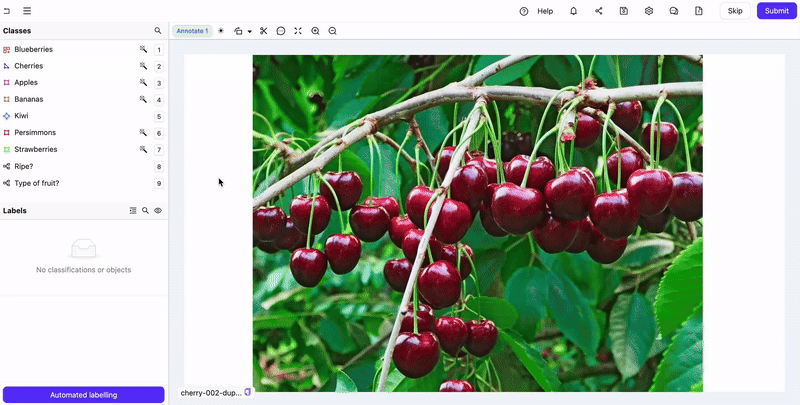 Grayscale DICOM/NIfTi
Grayscale DICOM/NIfTi
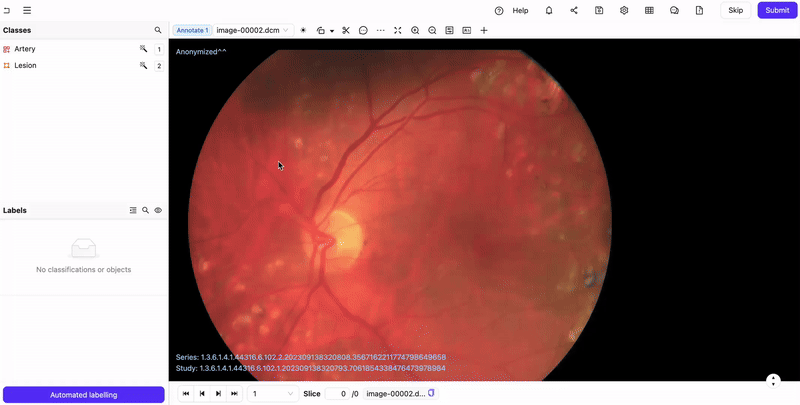
Media Navigation Controls
The video frame slider lets you quickly scroll through frames in a video asset. Below the frame slider are a range of controls to let you play, skip and navigate through media. Notice that the navigation controls are not displayed in single images files, as well as any media with only 1 frame. Icon descriptions:
Issues and Comments
Issues can be added to annotation and review tasks to communicate with other users. All issues contain comment threads relating to the entire task or specific sections of the task. A small notification badge on the Issues icon displays the number of unresolved issues in a task.- Label rejection: Created when a reviewer rejects labels. The reviewer is prompted to provide a reason for the rejection in the form of a comment. If all instances in a frame or image are rejected, a separate rejection issue is created for each label. Labels with rejection issues display a red Issues icon next to the instance name, which turns green once the issue is resolved.
- File: Apply to the entire file and can be created at any stage within the Label Editor.
- Pinned: Apply to a specific part of the file or frame and can be created at any stage within the Label Editor. Red Pin icons indicate unresolved issues and remain red until they are marked as resolved.
- Frame: Apply to a specific frame and can be created at any stage within the Label Editor. Frame issues can only be created when multiple frames are present; such as in a video, image sequence, or DICOM volume.
- Frame range: Apply to a range of frames and can be created at any stage within the Label Editor. Frame range issues can only be created when multiple frames are present; such as in a video, image sequence, or DICOM volume. Frame range issues can only be created in Encord Active.
- Task requirement: Are created for each object or classification marked Required in the Ontology. The issue is resolved when the required object or classification is applied. Task requirement issues are the only issues visible in a Consensus annotate stage.
Issues cannot be created in a Consensus annotate stage.
- Open the Issues pane by clicking the Issues icon.
- Click the New issue icon (or keyboard shortcut Ctrl+N).
- Click the Apply to dropdown to select the type of issue you want to create.
- Select any Issue Tags you want to apply to the issue.
- Add a comment to the issue.
- If you selected ‘Pin on canvass’ in Step 3, click the desired location on the canvas.
- Click Create issue.
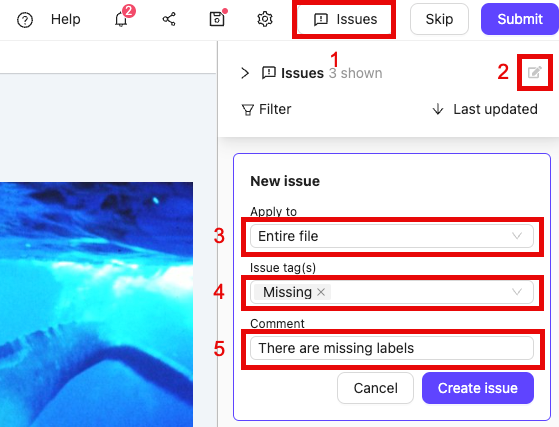
- Open the Issues pane by clicking the Issues icon.
- Click the tick to mark a thread as resolved.
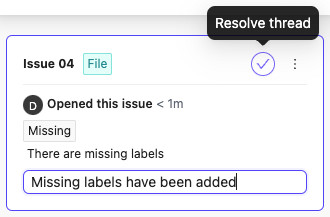
- Open the Issues pane by clicking the Issues icon.
- Click the Ellipsis icon to show more options.
- Click Delete thread.
Users can only delete issues that they created. Label rejections cannot be deleted, only resolved.
- Open the Issues pane by clicking the Issues icon.
- Click Reopen on an issue that was previously resolved.
- Ask questions: Annotators and reviewers can ask questions about the task. Admins can use this feedback to improve guidance.
- Explain task rejection: Reviewers can provide reasons for rejection, helping annotators avoid repeating mistakes.
- Track unresolved issues: Keep a record of open discussions that need follow-up before finalizing annotations.
Editor Lock
The ‘Editor lock’ is a safety feature we implemented to prevent several people making changes to the same file - annotators labeling, or reviewers reviewing the same data unit. A warning is triggered in two cases:- When you have the same task open in two different tabs or browser windows:

- When a different user is editing the same task:



